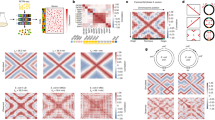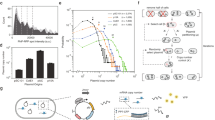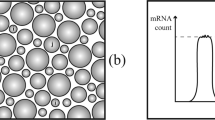Abstract
Single-cell measurements of mRNA copy numbers inform our understanding of stochastic gene expression1,2,3, but these measurements coarse-grain over the individual copies of the gene, where transcription and its regulation take place stochastically4,5. Here, we combine single-molecule quantification of mRNA and gene loci to measure the transcriptional activity of an endogenous gene in individual Escherichia coli bacteria. When interpreted using a theoretical model for mRNA dynamics, the single-cell data allow us to obtain the probabilistic rates of promoter switching, transcription initiation and elongation, mRNA release and degradation. Unexpectedly, we find that gene activity can be strongly coupled to the transcriptional state of another copy of the same gene present in the cell, and to the event of gene replication during the bacterial cell cycle. These gene-copy and cell-cycle correlations demonstrate the limits of mapping whole-cell mRNA numbers to the underlying stochastic gene activity and highlight the contribution of previously hidden variables to the observed population heterogeneity.
This is a preview of subscription content, access via your institution
Access options
Access Nature and 54 other Nature Portfolio journals
Get Nature+, our best-value online-access subscription
$29.99 / 30 days
cancel any time
Subscribe to this journal
Receive 12 digital issues and online access to articles
$119.00 per year
only $9.92 per issue
Buy this article
- Purchase on Springer Link
- Instant access to full article PDF
Prices may be subject to local taxes which are calculated during checkout




Similar content being viewed by others
Data availability
The data that support the findings of this study are available from the corresponding author on request.
Code availability
The custom MATLAB routines used for processing and analysing the fluorescence microscopy data are freely available from the corresponding author on request.
References
Sanchez, A. & Golding, I. Genetic determinants and cellular constraints in noisy gene expression. Science 342, 1188–1193 (2013).
Golding, I. et al. Real-time kinetics of gene activity in individual bacteria. Cell 123, 1025–1036 (2005).
Taniguchi, Y. et al. Quantifying E. coli proteome and transcriptome with single-molecule sensitivity in single cells. Science 329, 533–538 (2010).
Jones, D. L., Brewster, R. C. & Phillips, R. Promoter architecture dictates cell-to-cell variability in gene expression. Science 346, 1533–1536 (2014).
Sepúlveda, L. A. et al. Measurement of gene regulation in individual cells reveals rapid switching between promoter states. Science 351, 1218–1222 (2016).
Raj, A. et al. Stochastic mRNA synthesis in mammalian cells. PLoS Biol. 4, e309 (2006).
So, L. H. et al. General properties of transcriptional time series in Escherichia coli. Nat. Genet. 43, 554–560 (2011).
Peterson, J. R. et al. Effects of DNA replication on mRNA noise. Proc. Natl Acad. Sci. USA 112, 15886–15891 (2015).
Zenklusen, D., Larson, D. R. & Singer, R. H. Single-RNA counting reveals alternative modes of gene expression in yeast. Nat. Struct. Mol. Biol. 15, 1263–1271 (2008).
Joshi, M. C. et al. Escherichia coli sister chromosome separation includes an abrupt global transition with concomitant release of late-splitting intersister snaps. Proc. Natl Acad. Sci. USA 108, 2765–2770 (2011).
Skinner, S. O. et al. Measuring mRNA copy number in individual Escherichia coli cells using single-molecule fluorescent in situ hybridization. Nat. Protoc. 8, 1100–1113 (2013).
French, S. L. & Miller, O. L. Jr. Transcription mapping of the Escherichia coli chromosome by electron microscopy. J. Bacteriol. 171, 4207–4216 (1989).
Golding, I. & Cox, E. C. RNA dynamics in live Escherichia coli cells. Proc. Natl Acad. Sci. USA 101, 11310–11315 (2004).
Elf, J., Li, G. W. & Xie, X. S. Probing transcription factor dynamics at the single-molecule level in a living cell. Science 316, 1191–1194 (2007).
Choubey, S., Kondev, J. & Sanchez, A. Deciphering transcriptional dynamics in vivo by counting nascent RNA molecules. PLoS Comput. Biol. 11, e1004345 (2015).
Xu, H. et al. Stochastic kinetics of nascent RNA. Phys. Rev. Lett. 117, 128101 (2016).
Chen, H. et al. Genome-wide study of mRNA degradation and transcript elongation in Escherichia coli. Mol. Syst. Biol. 11, 781 (2015).
Kuhlman, T. et al. Combinatorial transcriptional control of the lactose operon of Escherichia coli. Proc. Natl Acad. Sci. USA 104, 6043–6048 (2007).
Moffitt, J. R. et al. Spatial organization shapes the turnover of a bacterial transcriptome. eLife 5, e13065 (2016).
Proshkin, S. et al. Cooperation between translating ribosomes and RNA polymerase in transcription elongation. Science 328, 504–508 (2010).
Epshtein, V. & Nudler, E. Cooperation between RNA polymerase molecules in transcription elongation. Science 300, 801–805 (2003).
Senecal, A. et al. Transcription factors modulate c-Fos transcriptional bursts. Cell Rep. 8, 75–83 (2014).
Skinner, S. O. et al. Single-cell analysis of transcription kinetics across the cell cycle. eLife 5, e12175 (2016).
Neidhardt, F. C., Ingraham, J. L. & Schaechter, M. Physiology of the Bacterial Cell: a Molecular Approach (Sinauer Associates, 1990).
Wallden, M. et al. The synchronization of replication and division cycles in individual E. coli cells. Cell 166, 729–739 (2016).
Elowitz, M. B. et al. Stochastic gene expression in a single cell. Science 297, 1183–1186 (2002).
Guptasarma, P. Does replication-induced transcription regulate synthesis of the myriad low copy number proteins of Escherichia coli? BioEssays 17, 987–997 (1995).
Hammar, P. et al. Direct measurement of transcription factor dissociation excludes a simple operator occupancy model for gene regulation. Nat. Genet. 46, 405–408 (2014).
Golding, I. Infection by bacteriophage lambda: an evolving paradigm for cellular individuality. Curr. Opin. Microbiol. 43, 9–13 (2017).
Symmons, O. & Raj, A. What’s luck got to do with it: single cells, multiple fates, and biological nondeterminism. Mol. Cell 62, 788–802 (2016).
Lau, I. F. et al. Spatial and temporal organization of replicating Escherichia coli chromosomes. Mol. Microbiol. 49, 731–743 (2003).
Baba, T. et al. Construction of Escherichia coli K‐12 in‐frame, single‐gene knockout mutants: the Keio collection. Mol. Syst. Biol. 2, 2006.0008 (2006).
Ellermeier, C. D., Janakiraman, A. & Slauch, J. M. Construction of targeted single copy lac fusions using λ Red and FLP-mediated site-specific recombination in bacteria. Gene 290, 153–161 (2002).
Thomason, L. et al. Recombineering: genetic engineering in bacteria using homologous recombination. Curr. Protoc. Mol. Biol. 78, 1.16.1–1.16.24 (2007).
Cherepanov, P. P. & Wackernagel, W. Gene disruption in Escherichia coli: TcR and KmR cassettes with the option of Flp-catalyzed excision of the antibiotic-resistance determinant. Gene 158, 9–14 (1995).
Datsenko, K. A. & Wanner, B. L. One-step inactivation of chromosomal genes in Escherichia coli K-12 using PCR products. Proc. Natl Acad. Sci. USA 97, 6640–6645 (2000).
Schmidl, S. R. et al. Refactoring and optimization of light-switchable Escherichia coli two-component systems. ACS Synth. Biol. 3, 820–831 (2014).
Engler, C., Kandzia, R. & Marillonnet, S. A one pot, one step, precision cloning method with high throughput capability. PloS ONE 3, e3647 (2008).
Bernstein, J. A. et al. Global analysis of mRNA decay and abundance in Escherichia coli at single-gene resolution using two-color fluorescent DNA microarrays. Proc. Natl Acad. Sci. USA 99, 9697–9702 (2002).
Llopis, J. et al. Measurement of cytosolic, mitochondrial, and Golgi pH in single living cells with green fluorescent proteins. Proc. Natl Acad. Sci. USA 95, 6803–6808 (1998).
Young, J. W. et al. Measuring single-cell gene expression dynamics in bacteria using fluorescence time-lapse microscopy. Nat. Protoc. 7, 80–88 (2012).
Olivo-Marin, J.-C. Extraction of spots in biological images using multiscale products. Pattern Recognit. 35, 1989–1996 (2002).
Bates, D. & Kleckner, N. Chromosome and replisome dynamics in E. coli: loss of sister cohesion triggers global chromosome movement and mediates chromosome segregation. Cell 121, 899–911 (2005).
Nielsen, H. J. et al. Progressive segregation of the Escherichia coli chromosome. Mol. Microbiol. 61, 383–393 (2006).
Nielsen, H. J. et al. Dynamics of Escherichia coli chromosome segregation during multifork replication. J. Bacteriol. 189, 8660–8666 (2007).
Xu, H. et al. Combining protein and mRNA quantification to decipher transcriptional regulation. Nat. Methods 12, 739–742 (2015).
Acknowledgements
We are grateful to the following people for their generous advice and for providing reagents: D. Bates, J. Elf, H. Garcia, M. Girard, J. Halliday, C. Herman, M. Joshi, D. Magnan, J. Moffitt, E. Nudler, R. Phillips, A. Sarrion-Perdigones, S. Sebastian, L. Sepúlveda, A. Singh, P. Sivaramakrishnan, S. Skinner, A. Sokac, J. Tabor, K. Venken and all the members of the Golding lab. Work in the Golding lab is supported by grants from the National Institutes of Health (grant no. R01 GM082837), the National Science Foundation (grant nos. PHY 1147498, PHY 1430124 and PHY 1427654), the Welch Foundation (grant no. Q-1759) and the John S. Dunn Foundation (Collaborative Research Award). H.X. was supported by the Burroughs Wellcome Fund Career Award at the Scientific Interface (grant no. 1013907), the Thousand Talents Plan of China (Programme for Young Professionals), the National Natural Science Foundation of China (grant no. 11774225), the National Key Research and Development Programme of China (grant no. 2018YFC0310800) and the National Science Foundation of Shanghai (grant no. 18ZR1419800). We gratefully acknowledge the computing resources provided by the CIBR Center of the Baylor College of Medicine.
Author information
Authors and Affiliations
Contributions
M.W., J.Z., H.X. and I.G. designed the experiments. M.W. and J.Z. performed the experiments. M.W., J.Z. and H.X. analysed the data. M.W., J.Z. and I.G. wrote this Letter.
Corresponding author
Ethics declarations
Competing interests
The authors declare no competing interests.
Additional information
Publisher’s note: Springer Nature remains neutral with regard to jurisdictional claims in published maps and institutional affiliations.
Supplementary information
Supplementary Information
Supplementary Discussion, Supplementary Note, Supplementary Figs. 1−37, Supplementary Tables 1−5 and Supplementary References.
Rights and permissions
About this article
Cite this article
Wang, M., Zhang, J., Xu, H. et al. Measuring transcription at a single gene copy reveals hidden drivers of bacterial individuality. Nat Microbiol 4, 2118–2127 (2019). https://doi.org/10.1038/s41564-019-0553-z
Received:
Accepted:
Published:
Issue Date:
DOI: https://doi.org/10.1038/s41564-019-0553-z
This article is cited by
-
Transcription–replication interactions reveal bacterial genome regulation
Nature (2024)
-
Gene expression model inference from snapshot RNA data using Bayesian non-parametrics
Nature Computational Science (2023)
-
Neural network aided approximation and parameter inference of non-Markovian models of gene expression
Nature Communications (2021)
-
Single-cell measurement of plasmid copy number and promoter activity
Nature Communications (2021)



